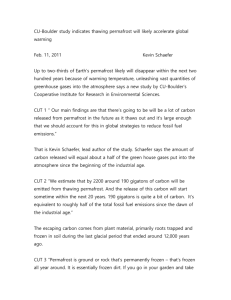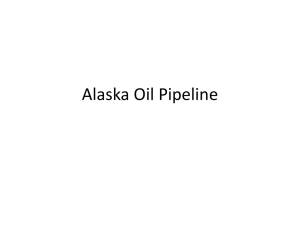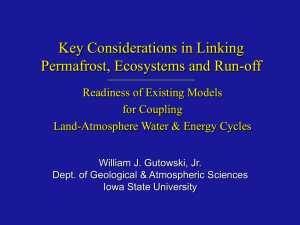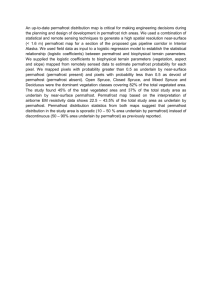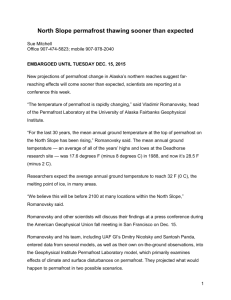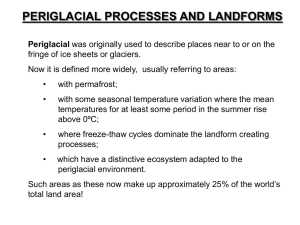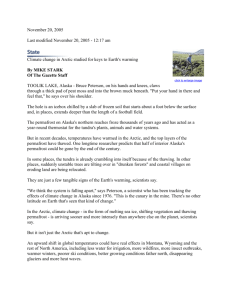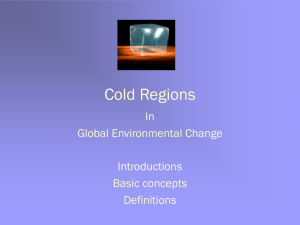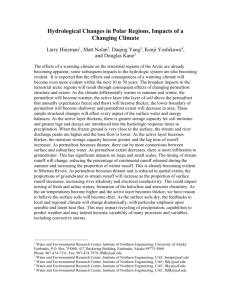thaw settlement
advertisement
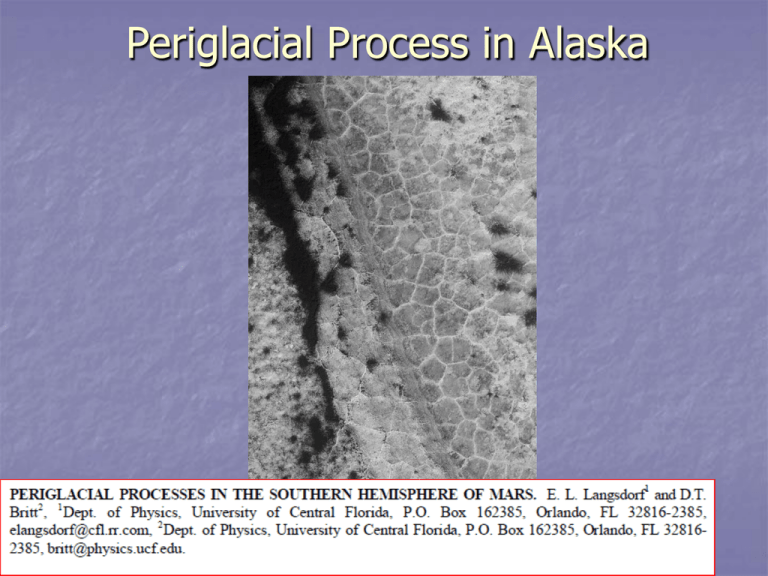
Periglacial Process in Alaska Application: Alaska Pipeline Permafrost regimes Tectonics Alaska Pipeline ~ 800 miles long (409 mi. buried; 382 mi. above ground) Trans Alaska Pipeline System (TAPS), formed by seven oil companies, announced plans in February 1969 to build a 4-foot diameter pipeline to carry crude oil from Prudhoe Bay to Valdez The temperature of the oil coming out of the ground was 80 deg C 1970 USGS Circular 632, "Some Estimates of the Thermal Effects of a Heated Pipeline in Permafrost” predicted that buried pipe would float, twist, and break Pipeline and storage tank construction at Valdez began in 1975 The initial estimated cost of installing 800 miles of buried pipeline was $900 million, and the actual cost was more than $8 billion Oil flows at 4 mph in the pipeline taking a week to reach Valdez http://menlocampus.wr.usgs.gov/50years/accomplishments/pipeline.html 145°F "There are 78,000 VSMs [vertical support members] and every single one of those had a 24inch hole drilled for it and every single one of them had a qualified person analyzing what came out of the hole to determine what kind of VSM it should be. There was actually a field design manual that was based on the soil." -- Bill Howitt, Alyeska engineer http://www.alyeska-pipe.com/pipelinefacts/PipelineEngineering.html http://geoimages.berkeley.edu/GeoImages/Johnson/Biomes/BiomesSub/AlaskaPipeline Thaw Lakes Thawing of the uppermost portion of the permafrost Melting of permafrost leads to subsidence Excess pore water is expelled Surrounding permafrost forms an impermeable bowl If depth> ~2m., lake will not freeze solid, developing unfrozen underlying material called a thaw bulb or talik Water absorbs more solar energy than soil Continued thawing leads to more subsidence and deepening of lake http://www.sciencefriday.com/vide os/watch/10008 Arctic environment change Thermokarst: Landscape features caused by structural failure following the melting of ground ice Results from deepening of the active layer and thawing of top of permafrost Thickening of the active layer has two immediate effects: Collapse, erosion, and slope instability assoc. with thawing permafrost Decomposed plant material frozen in the upper permafrost thaws, exposing the carbon to microbial decomposition, releasing carbon dioxide and methane to the atmosphere Ice in the upper permafrost is converted to water When ice-rich permafrost thaws, the ground surface subsides Arctic environment change This downward displacement of the ground surface is termed thaw settlement (Fig. 6). Settlement is nonuniform creating a chaotic surface with small hills and wet depressions known as thermokarst terrain Also common in areas underlain by ice wedges (Fig. 7). When thermokarst occurs beneath a road, house, pipeline, or airfield, the structural integrity is threatened. If thermokarst occurs in response to regional warming, large areas can subside and, if near the coast, can be inundated by encroaching seas. http://thermokarst.psu.edu/ A 40-mile stretch of Alaskan coastline along the Beaufort Sea is eroding at a rate of 45 feet per year. That's double the erosion rate of just a few years ago. A study describing the work was recently published in Geophysical Research Letters. Changing conditions such as declining sea ice extent, increasing summertime sea-surface temperature, rising sea level, and increases in storm power may have all contributed to the coastal decline A cabin along the Arctic Alaska coastline was recently washed into the ocean because the bluff it was sitting on top of was eroded away. Courtesy of Benjamin Jones, USGS http://www.sciencefriday.com/program/archives/200903273 USGS researcher Benjamin Jones measures erosion along a part of Alaska’s Arctic coast. Courtesy of Christopher Arp, USGS Rising temperatures are causing a reduction in sea ice and thawing of permafrost along the coast. Reduced sea ice allows higher storm surges to reach the shore and the thawing permafrost makes the shoreline more vulnerable to erosion. excerpt from Arctic Climate Assessment, Internat’l Arctic Science Committee, 2008, http://www.acia.uaf.edu/
